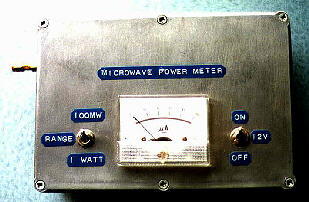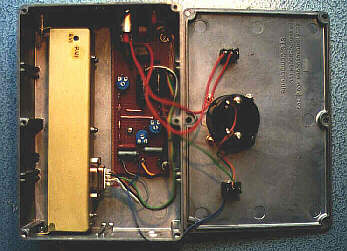 External view of simple power
meter.
External view of simple power
meter.
(after a design by Derek Atter, G3GRO)
RF power measurement at microwave frequencies can often be a hit and miss affair. Being a Yorkshireman by birth, the writer is not prone to spend lots of money where it can be avoided (!), and therefore this little unit is his attempt to get accurate results without the need for a Hewlett Packard machine.........
A couple of years ago a most useful little module became available at the UK amateur radio rallies (" hamfests" to American readers). It is called a "CW Power Monitor Type 2A2A10".
Basically, in its original form, it consists of an SMA input to a 35dB, 2 watt, connectorised attenuator (rated to 12.4GHz) followed by an Omni Spectra microwave detector diode (rated at 40mW input at 18GHz) which in turn feeds a 741H dc differential op amp. A nine-pin output D socket completes the module, which comes in an open aluminium alloy box (6 x 1 x 1 inches) complete with mounting flanges (see photo below).
 External view of simple power
meter.
External view of simple power
meter.
The CW Power Monitor module is on the left of the photograph while the D
socket connects the module to the meter scale expansion unit, added by the
writer, to a design by Derek Atter,
G3GRO, and built on veroboard.
and built on veroboard.
The meter expansion circuit was added to linearise the the meter scale since, at power inputs greater than 300mW to the 35dB attenuator, the detector diode characteristics depart from a square law and the transfer characteristic of the op-amp output versus RF power output begins to flatten off.
I calibrated my power meter on 10GHz, against a laboratory standard HP one. It seems to stay accurate up to 12GHz but as you go lower in frequency the sensitivity falls such that at 5.7GHz it is about minus 1dB down on 10GHz and even lower at 1.3GHz. However it would be possible to have a sensitivity correction control fitted, similar to those on the HP 345c for example.
I have used the unit to get relative power indication at 24GHz. A true 40mW seems to read around 60mW on the meter but I have not accurately assessed the calibration at this frequency yet since there are a lot of hidden variables that come into the assessment (not the least of which is the effect of the connectors used!).
The power meter runs off a 12 volt DC supply and draws very little current.
Full details of this power meter can be found in the RSGB Microwave Newsletter issues for November 1993 and June 1994.
![]() RETURN TO SIMPLE TEST GEAR INTRODUCTION
RETURN TO SIMPLE TEST GEAR INTRODUCTION